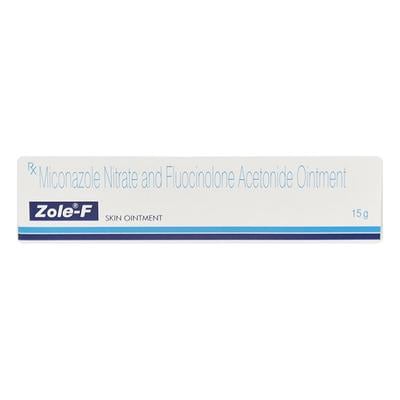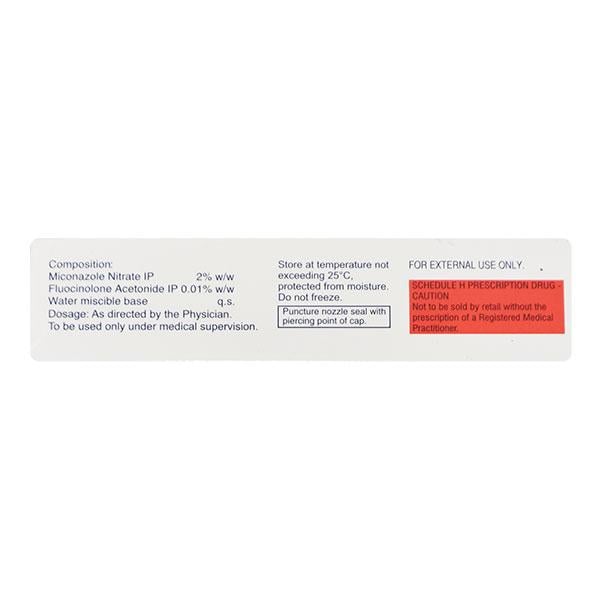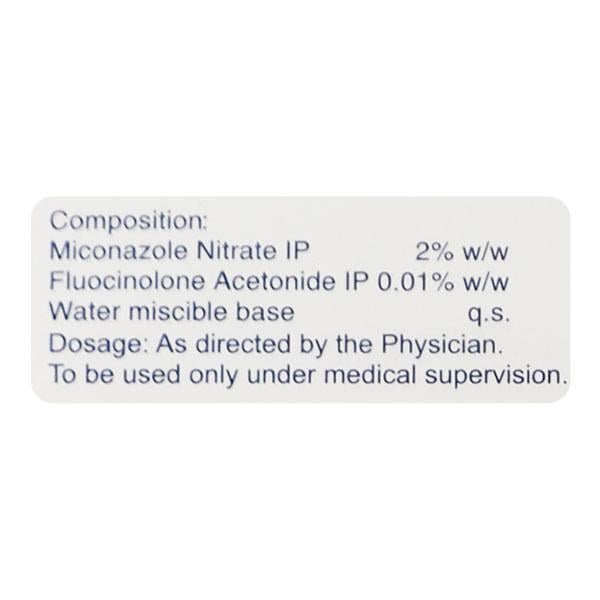

Netmeds First Membership
Quick Links
Introduction About ZOLE F OINTMENT
ZOLE F OINTMENT is a combination of Fluocinolone and Miconazole which belongs to the group of medicines called Corticosteroids and Antifungals respectively. It is used to manage various skin infections athlete’s foot (Tinea pedis), ringworm (Tinea corporis), vaginal thrush, and sweat rash.
A fungal infection (also called mycosis) is a skin disease that is caused by a fungus when it enters the tissue. Fungal infections can be contagious and spread from one person to another person.
Avoid ZOLE F OINTMENT contact with eyes. ZOLE F OINTMENT is not recommended for use in patients having rosacea (a skin condition that causes blushing or flushing and visible blood vessels in the face), acne, perioral dermatitis, anogenital pruritus, and napkin eruptions.
ZOLE F OINTMENT is not recommended for use in pregnant and breastfeeding women unless considered clearly necessary.
ZOLE F OINTMENT is not recommended in children and adolescents (below 12 years of age). It should be used with caution in elderly patients. Consult your doctor for advice before taking the medicine.
The most common side effects of ZOLE F OINTMENT are application site reactions (like burning, irritation, itching, and redness). If any of these symptoms worsen, consult your physician.
Uses Of ZOLE F OINTMENT
It is used to manage skin infections such as:
- athlete’s foot (Tinea pedis)
- ringworm (Tinea corporis)
- vaginal thrush
- sweat rash
How ZOLE F OINTMENT Works
ZOLE F OINTMENT is a combination of Fluocinolone and Miconazole. Fluocinolone works by blocking the production of certain chemical messengers (prostaglandins) that make the skin red, swollen, and itchy. Miconazole is an antifungal which stops the growth of fungi on the skin by managing them from forming their own protective covering. Thus, both together Fluocinolone and Miconazole help to manage various skin infections.
How to use ZOLE F OINTMENT
Apply ZOLE F OINTMENT as directed by your physician. Clean and dry the area which is affected before the application. It is for external use only. Wash hands before and after the application ZOLE F OINTMENT. Your doctor will decide the right dose depending on your age, body weight and disease condition.
Side Effects Of ZOLE F OINTMENT
Common
- application site reactions (burning, irritation, itching, and redness)
Rare
Stop using ZOLE F OINTMENT and contact your physician immediately if you experience any of the following side effects:
- vaginal burning or itching
- lower abdominal cramps
- headache
- severe allergic reactions (signs include swelling of the face, lips, mouth, throat, or tongue, difficulty in swallowing or breathing, itchy rash)
How To Manage Side Effects
Itching of the skin:
Avoid hot baths because hot water can irritate the skin. Do not scratch the affected area. Use sunscreen and protective clothing when outdoors. Regularly use unscented moisturizers to soothe and hydrate the affected area. Contact your doctor if the itching worsens.
Warning & Precautions
Pregnancy
ZOLE F OINTMENT is generally not recommended for use in pregnant women or women trying to become pregnant. Consult your doctor for advice.
Breastfeeding
ZOLE F OINTMENT is generally not recommended for use in breastfeeding women. Consult your doctor for advice.
Allergy
Do not apply ZOLE F OINTMENT if you are allergic to Fluocinolone, Miconazole, or to other ingredients of this medicine.
Others
ZOLE F OINTMENT is not recommended for use if you have:
- rosacea (a skin condition that causes blushing or flushing and visible blood vessels in the face)
- acne
- perioral dermatitis
- anogenital pruritus
- napkin eruptions
Use in paediatrics:
ZOLE F OINTMENT is generally not recommended for use in children and adolescents (below 12 years of age). Consult your doctor for advice.
Use in geriatrics:
In elderly patients ZOLE F OINTMENT should be used with caution. Consult your doctor for advice.
Interactions
A. Drug - Drug interactions:
Before using ZOLE F OINTMENT, inform your doctor if you are taking any of the following medicine:
- medicine used to thin the blood (Ex. warfarin)
Overdosage:
If you or anyone else accidentally swallow this ZOLE F OINTMENT, consult your doctor immediately or visit the nearby hospital.
Synopsis
| Drug | : | Fluocinolone, Miconazole |
| Pharmacological Category | : | Corticosteroid and Antifungals |
| Therapeutic Indication | : | Manages skin infections |
| Dosage Forms | : | Ointment, Cream, Lotion, Gel |
More Information
- Keep ZOLE F OINTMENT out of reach of children
- Store at room temperature
FAQs About ZOLE F OINTMENT
Q: What for ZOLE F OINTMENT used?
A: It is used to manage various skin infections athlete’s foot (Tinea pedis), ringworm (Tinea corporis), vaginal thrush, and sweat rash.
Q: When to seek medical emergency while using ZOLE F OINTMENT?
A: Stop using ZOLE F OINTMENT and contact your doctor immediately if you experience vaginal burning or itching, lower abdominal cramps, headache, and severe allergic reactions (signs include swelling of the face, lips, mouth, throat, or tongue, difficulty in swallowing or breathing, itchy rash.
Q: Can ZOLE F OINTMENT be used in pregnant women?
A: No, ZOLE F OINTMENT is not recommended for use in pregnant women or women of childbearing age. So, inform your doctor if you think you may be pregnant or are planning to have a baby, before taking this medicine.
Q: What to do if I forget to use ZOLE F OINTMENT?
A: ZOLE F OINTMENT should be used immediately when you remember. If it is time for your next dose skip the missed one and follow your regular scheduled dose. Do not take a double dose to match up your missed dose.
Q: What are the most common side effects of ZOLE F OINTMENT?
A: The most common side effects of ZOLE F OINTMENT are application site reactions (like burning, irritation, itching, and redness). If any of these symptoms worsen, consult your physician.
References
1. KD. Tripathi. Drugs Acting on Skin and Mucous Membranes and Antifungal Drugs. Essentials of medical pharmacology. Seventh edition. 2013. Page – 886-896,787-797.
2. Victoria Montoro, Carlos Asensio, Ángel Martínez, Juan Lorente, Francisco J. Rodríguez, José Montojo, Javier Gavilanes, Pedro Sarría, Cristóbal Langdon, and Eduard Prades. Efficacy randomized, double-blind, placebo-controlled clinical trial. Journal of International Medical Research. August 2018. [Accessed on 1st July 2022] https://www.ncbi.nlm.nih.gov/pmc/articles/PMC6166331/
3. Bo-Young Kim, Hyok-rae Cho, Dongjun Lee, Seong-Kug Eo and Koanhoi Kim. Miconazole Suppresses 27-Hydroxycholesterol-induced Inflammation by Regulating Activation of Monocytic Cell to a Proinflammatory Phenotype. Frontiers Pharmacol. October 2021. [Accessed on 1st July 2022] https://www.frontiersin.org/articles/10.3389/fphar.2021.691019/full
4. Miconazole Nitrate and Fluocinolone Acetonide. wellonapharma.com. [Accessed on 1st July 2022] https://wellonapharma.com/product/finished/miconazole-nitrate-and-fluocinolone-acetonide-cream
5. Fluocinolone. arpimed.am. [Accessed on 1st July 2022] https://arpimed.am/fluocinolone-0-025-ointment/
6. Janssen Pharmaceutica NV. Electronic Medicines Compendium (EMC). [Revised on September 2020] [Revised on 1st July 2022] https://www.medicines.org.uk/emc/files/pil.443.pdf
7. Medimetriks Pharmaceuticals. U.S. Food & Drug Administration. [Accessed on 1st July 2022] https://www.accessdata.fda.gov/drugsatfda_docs/label/2012/015296s064lbl.pdf
8. Miconazole Nitrate and Fluocinolone Acetonide. wockhardtepharmacy.com. [Accessed on 1st July 2022] https://wockhardtepharmacy.com/product/zole-f-cream-15gm/
9. Miconazole Nitrate and Fluocinolone Acetonide. www.unitedpharmacies.md. [Accessed on 1st July 2022] https://www.unitedpharmacies.md/Zole-F-Ointment-Miconazole-Fluocinolone.html
10. Miconazole Nitrate and Fluocinolone Acetonide. wockhardtepharmacy.com. [Accessed on 1st July 2022] https://wockhardtepharmacy.com/product/zole-f-lotion-15ml/












